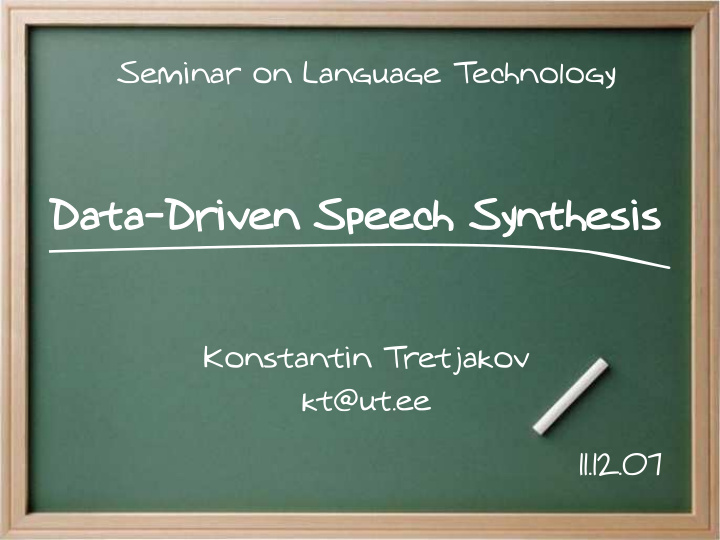



Seminar on Language Technology Dat Data- a-Dri Drive ven Spe n Speech ech Synt nthe hesis Konstantin Tretjakov kt@ut.ee 11.12.07
Speech Synthesis “Computers are getting smarter all the time. Scientists tell us that soon they will be able to talk with us. (By “they”, I mean computers. I doubt scientists will ever be able to talk to us.) - Dave Barry
Speech Synthesis in year 1791
Speech Synthesis in year 1835 J. Faber “Euphonia” http://www.ling.su.se/staff/hartmut/kemplne.htm
Speech Synthesis in year 1937 Riesz Model http://www.ling.su.se/staff/hartmut/kemplne.htm
Speech Synthesis in year 1939 H.Dudley “VODER” http://www.ling.su.se/staff/hartmut/kemplne.htm
Speech Synthesis in year 1939 H.Dudley “VODER” http://www.ling.su.se/staff/hartmut/kemplne.htm
Speech Synthesis in year 1953 Gunnar Fant's “OVE” (Orator Verbis Electris) Formant Synthesizer for vowels http://www.ling.su.se/staff/hartmut/kemplne.htm
Formant Synthesis
http://www.geofex.com/Article_Folders/wahpedl/voicewah.htm
Modern Speech Synthesis ● 1968 - First full TTS (Umeda et al.) ● 1977 – Diphone concat. (J. Olive) ● 1979 – MITTalk (Allen et al) ● 1984 – DECTalk (Klatt, DEC) ● 1995 – Eurovocs ● 200? - IBM
Modern Speech Synthesis ● 1968 - First full TTS (Umeda et al.) ● 1977 – Diphone concat. (J. Olive) ● 1979 – MITTalk (Allen et al) ● 1984 – DECTalk (Klatt, DEC) ● 1995 – Eurovocs Rule-based ● 200? - IBM Data-driven
Outline ● History of Speech Synthesis ● Text-To-Speech System Architecture
Text-to-Speech System Text Text Analysi Analysis ● Text normalization ● PoS tagging Phoneti onetic c analys nalysis ● Homonym disambiguation ● Dictionary Lookup ● Grapheme-to-Phoneme Pros rosod odic A ic Ana nalys lysis is ● Boundary placement ● Pitch accent assignment ● Duration computation Wa Wavefor orm Synth ynthes esis is http://www.stanford.edu/class/linguist236/
Text-to-Speech System Data-driven? Text Text Analysi Analysis ● Text normalization ● PoS tagging Phoneti onetic c analys nalysis ● Homonym disambiguation ● Dictionary Lookup ● Grapheme-to-Phoneme Pros rosod odic A ic Ana nalys lysis is ● Boundary placement ● Pitch accent assignment ● Duration computation Wa Wavefor orm Synth ynthes esis is
1) Text Normalization ● He stole $100 million from the bank. ● It's 13 St. Andrews St. ● The home page is http://www.ut.ee. Method: ● Split to tokens. ● Map tokens to words. ● Identify types for words.
2) Phonetic Analysis ● My latest project is to learn how to better project my voice. ● On May 5 1996, the university bought 1996 computers. ● Yesterday it rained 3 in. Take 1 out, then put 3 in.
2) Phonetic Analysis ● How to pronounce a word? – Look in the dictionary! ● But what about unknown words and names? ● Complex languages: German/French/Turkish – Letter to sound rules ● .. also neural networks (NETTalk) ● .. pr. by analogy (PRONOUNCE) ● .. case-based (MBRTalk) more later ● ... and muc uch more.
3) Prosodic Analysis ● Prosody: phrases, accents, F0 contour, duration ● The Tilt Intonation Model e.g. Trees
4) Waveform synthesis ● Articulatory synthesis (a-la VODER) ● Formant (a-la OVE) ● Concatenative synthesis – Domain-specific (“talking clock”, “weather”) – Diphones (PSOLA, MBROLA) – Unit selection
4) Waveform synthesis ● Domain-specific synthesis is easy: #!/bin/bash hours=`date +"%-l"` mins=`date +"%-M"` ampm=`date +"%-P"` play $hours.wav play $mins.wav play $ampm.wav
4) Waveform synthesis ● Diphone synthesis – Use diphones: middle of one phone to middle of next. – Just a bit of DSP to connect diphones. ● PSOLA ● MBROLA
4) Waveform synthesis ● Unit selection – Use the entire speech corpus as the acoustic inventory. – Select at runtime the longest available string of phonetic segments. – Minimize number of concatenations. – Reduce DSP.
Text-to-Speech System Data-driven? Text Text Analysi Analysis ● Text normalization ● PoS tagging Phoneti onetic c analys nalysis ● Homonym disambiguation ● Dictionary Lookup ● Grapheme-to-Phoneme Pros rosod odic A ic Ana nalys lysis is ● Boundary placement ● Pitch accent assignment ● Duration computation Wa Wavefor orm Synth ynthes esis is
Text-to-Speech System Data-driven? Text Text Analysi Analysis ● Text normalization ● PoS tagging Phoneti onetic c analys nalysis ● Homonym disambiguation ● Dictionary Lookup ● Grapheme-to-Phoneme Pros rosod odic A ic Ana nalys lysis is ● Boundary placement ● Pitch accent assignment ● Duration computation Wa Wavefor orm Synth ynthes esis is
Outline ● History of Speech Synthesis ● Text-To-Speech System Architecture ● Grapheme-to-Phoneme transcription
GTP transcription ● Lexicon: – “cepstra” -> (k eh p)' (s t r aa) – What about unknown words? – Commercial systems have 3-part system: ● Big dictionary ● Special code for names/acronyms/etc ● Mach Machine-learned ine-learned let letter ter-to-soun o-sound (LTS) syst (LTS) system em for other unknown words
Learning LTS rules ● Induce LTS from a dictionary of the language (Black et al. 1998) ● Two steps: – Alignment – Decision tree-based rule-induction
Alignment ● Letters: c h e c k e d ● Phones: ch _ eh _ k _ t ● Black et al. propose 2 methods: – Expectation-Maximization – Estimate p(letter | phone) from valid alignments, take best. ● Devil in the details
Decision trees for LTS ● Now that aligned data is available, train a decision tree: – ### c hek -> ch – che c ked -> _ ● 92-96% letter acc. (58-75% word acc.) for English
GTP transcription ● Decision-tree based (Black et al.) ● ANN-based (NETTalk, Sejnowski et al.) ● Pronunciation-by-Analogy (Damper et al.) ● Memory-based (MBRTalk, Stanfill) ● Transducer-based (I. Bulyko) ● Non-segmental (A. Cohen)
GTP transcription ● Decision-tree based (Black et al.) ● ANN-based (NETTalk, Sejnowski et al.) ● Pronunciation-by-Analogy (Damper et al.) ● Memory-based (MBRTalk, Stanfill) ● Transducer-based (I. Bulyko) ● Non-segmental (A. Cohen)
Outline ● History of Speech Synthesis ● Text-To-Speech System Architecture ● Grapheme-to-Phoneme transcription ● Conclusion
Text-to-Speech System Text Text Analysi Analysis ● Text normalization ● PoS tagging Phoneti onetic c analys nalysis ● Homonym disambiguation ● Dictionary Lookup ● Grapheme-to-Phoneme Pros rosod odic A ic Ana nalys lysis is ● Boundary placement ● Pitch accent assignment ● Duration computation Wa Wavefor orm Synth ynthes esis is http://www.stanford.edu/class/linguist236/
? ? ?
Recommend
More recommend